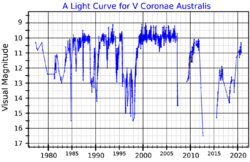Astronomy:V Coronae Australis
| Observation data Equinox J2000.0]] (ICRS) | |
|---|---|
| Constellation | Corona Australis |
| Right ascension | 18h 47m 32.30962s[2] |
| Declination | −38° 09′ 32.3079″[2] |
| Apparent magnitude (V) | 9.4 - 17.9[3] |
| Characteristics | |
| Evolutionary stage | R CrB[3] |
| Spectral type | R0[4] |
| Astrometry | |
| Proper motion (μ) | RA: −1.104[2] mas/yr Dec.: −7.531[2] mas/yr |
| Parallax (π) | −0.3793 ± 0.1513[2] mas |
| Distance | 5,500[5] pc |
| Details | |
| Mass | 0.6[6] M☉ |
| Luminosity | 6,550[5] L☉ |
| Surface gravity (log g) | 0.5[7] cgs |
| Temperature | 6,250[6] K |
| Other designations | |
| Database references | |
| SIMBAD | data |
V Coronae Australis (V CrA) is a R Coronae Borealis variable (RCB) star in the constellation Corona Australis. These are extremely hydrogen-deficient supergiants thought to have arisen as the result of the merger of two white dwarfs; fewer than 100 have been discovered as of 2012.[9] V Coronae Australis dimmed in brightness from 1994 to 1998.[10]
The visual apparent magnitude of V CrA has been observed to vary between magnitudes 9.4 and 17.9. A maximum magnitude of 8.3 has been estimated from photographic plates.[11] It has around 60% the mass of the Sun and an effective (surface) temperature of around 6250 K.[6]
The spectral class of R0 is typical of a carbon star, but the RCB stars are considered to a separate class of hydrogen-deficient stars, not normal asymptotic giant branch giants.[12]
References
- ↑ "Download Data". AAVSO. https://www.aavso.org/data-download.
- ↑ 2.0 2.1 2.2 2.3 2.4 Vallenari, A. et al. (2022). "Gaia Data Release 3. Summary of the content and survey properties". Astronomy & Astrophysics. doi:10.1051/0004-6361/202243940 Gaia DR3 record for this source at VizieR.
- ↑ 3.0 3.1 "V CrB". AAVSO. https://www.aavso.org/vsx/index.php?view=detail.top&oid=9876.
- ↑ Houk, N. (1982). Michigan Catalogue of Two-dimensional Spectral Types for the HD stars. Volume_3. Declinations −40° to −26°. Bibcode: 1982mcts.book.....H.
- ↑ 5.0 5.1 Montiel, Edward J.; Clayton, Geoffrey C.; Sugerman, B. E. K.; Evans, A.; Garcia-Hernández, D. A.; Kameswara Rao, N.; Matsuura, M.; Tisserand, P. et al. (2018). "The Double Dust Envelopes of R Coronae Borealis Stars". The Astronomical Journal 156 (4): 148. doi:10.3847/1538-3881/aad772. Bibcode: 2018AJ....156..148M.
- ↑ 6.0 6.1 6.2 Stasińska, G.; Szczerba, R.; Schmidt, M.; Siódmiak, N. (2006). "Post-AGB stars as testbeds of nucleosynthesis in AGB stars". Astronomy and Astrophysics 450 (2): 701. doi:10.1051/0004-6361:20053553. Bibcode: 2006A&A...450..701S.
- ↑ Hema, B. P.; Pandey, Gajendra; Lambert, David L. (2012). "The Galactic R Coronae Borealis Stars: The C2 Swan Bands, the Carbon Problem, and the 12C/13C Ratio". The Astrophysical Journal 747 (2): 102. doi:10.1088/0004-637X/747/2/102. Bibcode: 2012ApJ...747..102H.
- ↑ SIMBAD, V Coronae Australis (accessed 13 July 2014)
- ↑ Tisserand; Clayton; Welch; Pilecki; Wyrzykowski; Kilkenny (2012). "The Ongoing Pursuit of R Coronae Borealis Stars: ASAS-3 Survey Strikes Again". Astronomy & Astrophysics 551: 22. doi:10.1051/0004-6361/201220713. A77. Bibcode: 2013A&A...551A..77T.
- ↑ Skuljan, L.; Cottrell, P. L. (2002). "Recent declines of RS Telescopii, UW Centauri, and V Coronae Australis". The Observatory 122: 322–29. Bibcode: 2002Obs...122..322S.
- ↑ Milone, L. A. (1975). "A Note on V CrA and W Men". Information Bulletin on Variable Stars 989: 1. Bibcode: 1975IBVS..989....1M.
- ↑ Pandey, Gajendra; Hema, B. P.; Reddy, Arumalla B. S. (2021). "Revised Surface Abundances of R Coronae Borealis Stars". The Astrophysical Journal 921 (1): 52. doi:10.3847/1538-4357/ac1ad1. Bibcode: 2021ApJ...921...52P.
 |


